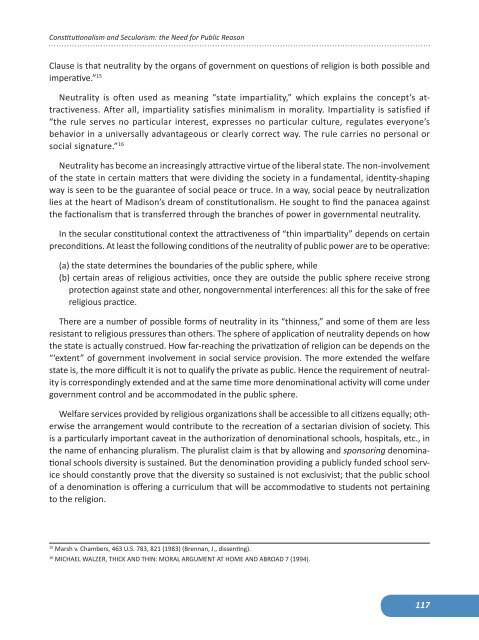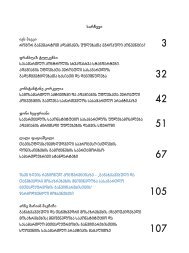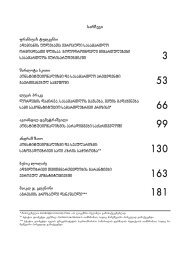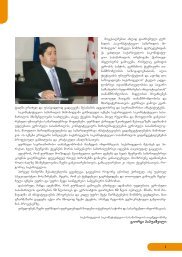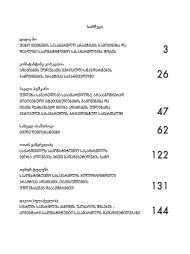Contents - Constitutional Court of Georgia
Contents - Constitutional Court of Georgia
Contents - Constitutional Court of Georgia
You also want an ePaper? Increase the reach of your titles
YUMPU automatically turns print PDFs into web optimized ePapers that Google loves.
<strong>Constitutional</strong>ism and Secularism: the Need for Public Reason<br />
Clause is that neutrality by the organs <strong>of</strong> government on questions <strong>of</strong> religion is both possible and<br />
imperative.” 15<br />
Neutrality is <strong>of</strong>ten used as meaning “state impartiality,” which explains the concept’s attractiveness.<br />
After all, impartiality satisfies minimalism in morality. Impartiality is satisfied if<br />
“the rule serves no particular interest, expresses no particular culture, regulates everyone’s<br />
behavior in a universally advantageous or clearly correct way. The rule carries no personal or<br />
social signature.” 16<br />
Neutrality has become an increasingly attractive virtue <strong>of</strong> the liberal state. The non-involvement<br />
<strong>of</strong> the state in certain matters that were dividing the society in a fundamental, identity-shaping<br />
way is seen to be the guarantee <strong>of</strong> social peace or truce. In a way, social peace by neutralization<br />
lies at the heart <strong>of</strong> Madison’s dream <strong>of</strong> constitutionalism. He sought to find the panacea against<br />
the factionalism that is transferred through the branches <strong>of</strong> power in governmental neutrality.<br />
In the secular constitutional context the attractiveness <strong>of</strong> “thin impartiality” depends on certain<br />
preconditions. At least the following conditions <strong>of</strong> the neutrality <strong>of</strong> public power are to be operativ e:<br />
(a) the state determines the boundaries <strong>of</strong> the public sphere, while<br />
(b) certain areas <strong>of</strong> religious activities, once they are outside the public sphere receive strong<br />
protection against state and other, non governmental interferences: all this for the sake <strong>of</strong> free<br />
religious practice.<br />
There are a number <strong>of</strong> possible forms <strong>of</strong> neutrality in its “thinness,” and some <strong>of</strong> them are less<br />
resistant to religious pressures than others. The sphere <strong>of</strong> application <strong>of</strong> neutrality depends on how<br />
the state is actually construed. How far-reaching the privatization <strong>of</strong> religion can be depends on the<br />
“‘extent” <strong>of</strong> government involvement in social service provision. The more extended the welfare<br />
state is, the more difficult it is not to qualify the private as public. Hence the requirement <strong>of</strong> neutrality<br />
is correspondingly extended and at the same time more denominational activity will come under<br />
government control and be accommodated in the public sphere.<br />
Welfare services provided by religious organizations shall be accessible to all citizens equally; otherwise<br />
the arrangement would contribute to the recreation <strong>of</strong> a sectarian division <strong>of</strong> society. This<br />
is a particularly important caveat in the authorization <strong>of</strong> denominational schools, hospitals, etc., in<br />
the name <strong>of</strong> enhancing pluralism. The pluralist claim is that by allowing and sponsoring denominational<br />
schools diversity is sustained. But the denomination providing a publicly funded school service<br />
should constantly prove that the diversity so sustained is not exclusivist; that the public school<br />
<strong>of</strong> a denomination is <strong>of</strong>fering a curriculum that will be accommodative to students not pertaining<br />
to the religion.<br />
15 Marsh v. Chambers, 463 U.S. 783, 821 (1983) (Brennan, J., dissenting).<br />
16 MICHAEL WALZER, THICK AND THIN: MORAL ARGUMENT AT HOME AND ABROAD 7 (1994).<br />
117


